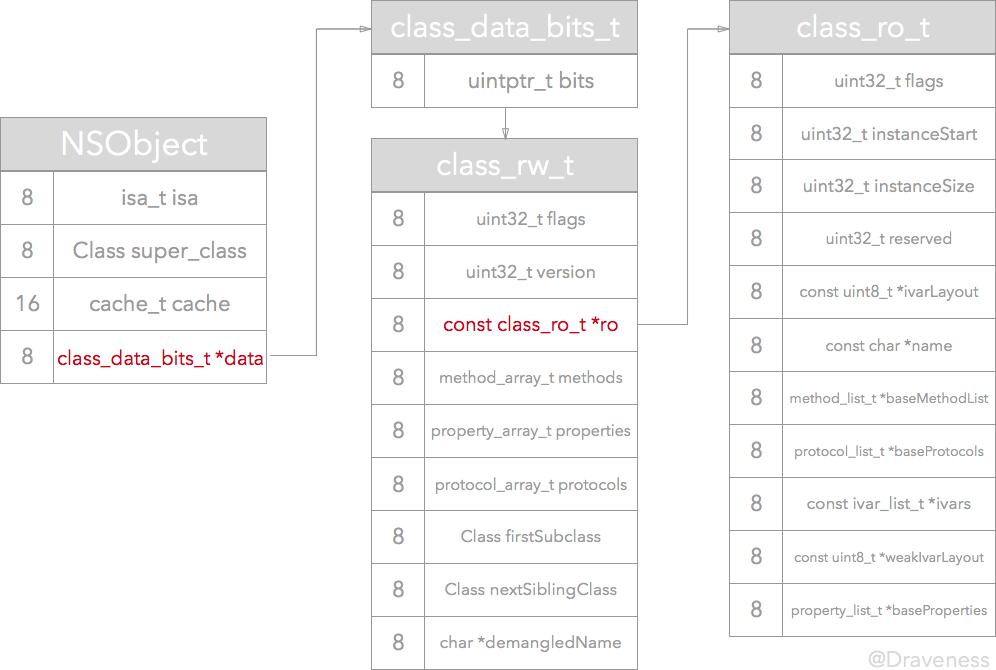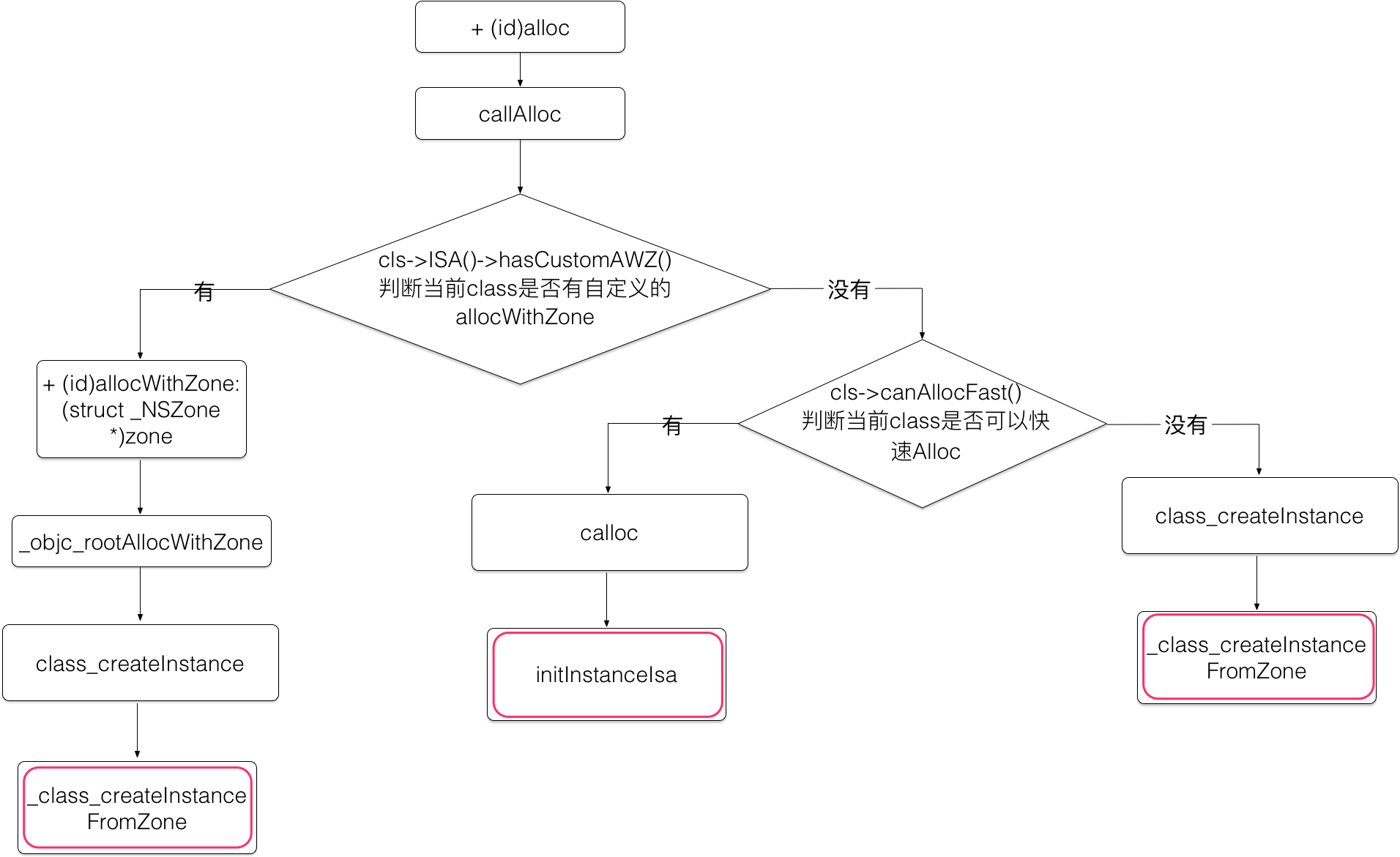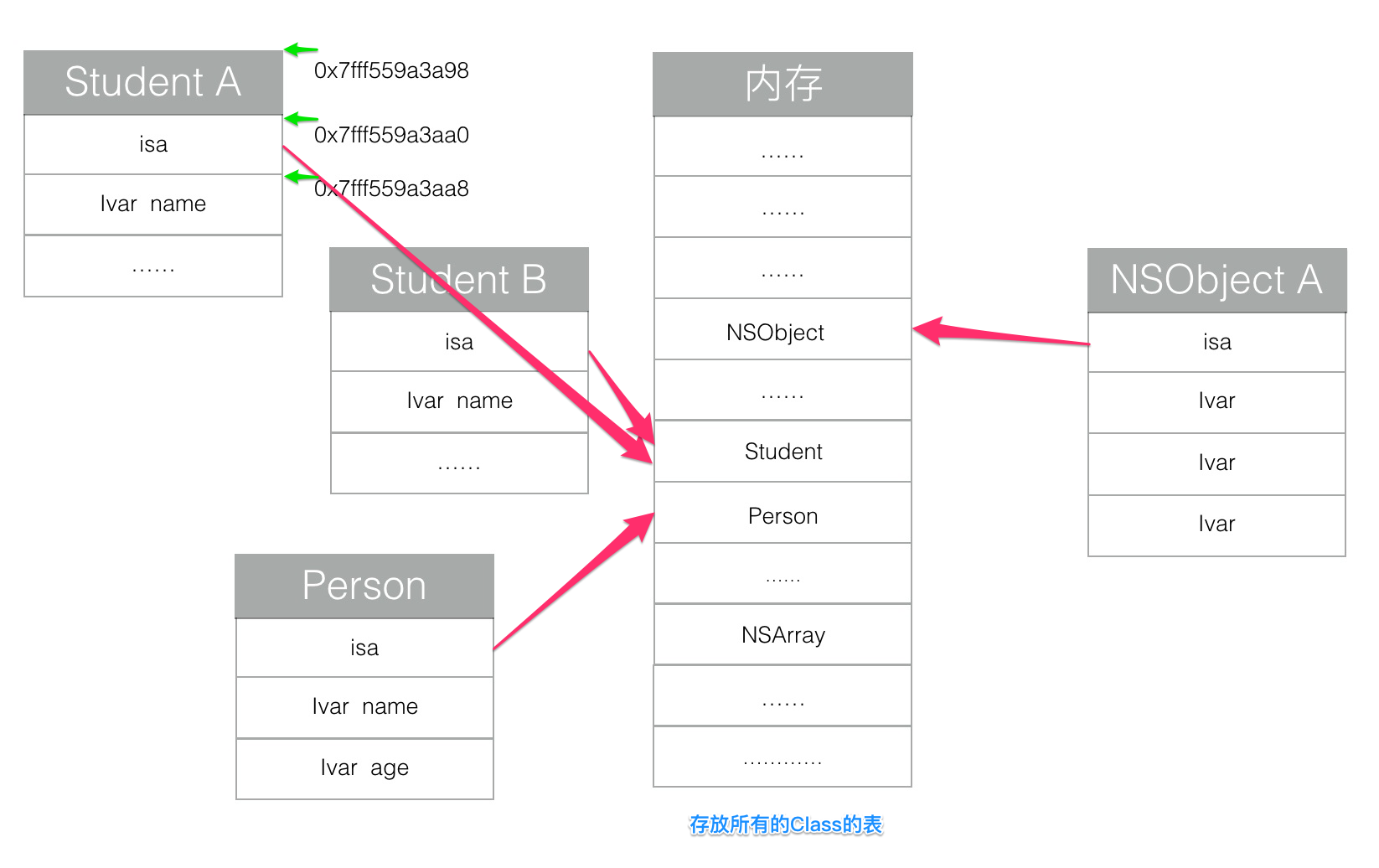Objc 对象的今生今世
前言
在面向对象编程中,我们每天都在创建对象,用对象描述着整个世界,然而对象是如何从孕育到销毁的呢?
目录
- 1.孕育对象
- 2.对象的出生
- 3.对象的成长
- 4.对象的销毁
- 5.总结
一.孕育对象

每天开发我们都在alloc对象,而alloc方法做了些什么呢?
+ (id)alloc {
return _objc_rootAlloc(self);
}
所有对象alloc都会调用这个root的方法
id _objc_rootAlloc(Class cls)
{
return callAlloc(cls, false/*checkNil*/, true/*allocWithZone*/);
}
这个方法又会去调用callAlloc方法
static ALWAYS_INLINE id callAlloc(Class cls, bool checkNil, bool allocWithZone=false)
{
if (checkNil && !cls) return nil;
#if __OBJC2__
if (! cls->ISA()->hasCustomAWZ()) {
// No alloc/allocWithZone implementation. Go straight to the allocator.
// fixme store hasCustomAWZ in the non-meta class and
// add it to canAllocFast's summary
if (cls->canAllocFast()) {
// No ctors, raw isa, etc. Go straight to the metal.
bool dtor = cls->hasCxxDtor();
id obj = (id)calloc(1, cls->bits.fastInstanceSize());
if (!obj) return callBadAllocHandler(cls);
obj->initInstanceIsa(cls, dtor);
return obj;
}
else {
// Has ctor or raw isa or something. Use the slower path.
id obj = class_createInstance(cls, 0);
if (!obj) return callBadAllocHandler(cls);
return obj;
}
}
#endif
// No shortcuts available.
if (allocWithZone) return [cls allocWithZone:nil];
return [cls alloc];
}
由于入参 checkNil = false,所以不会返回nil。
bool hasCustomAWZ() {
return ! bits.hasDefaultAWZ();
}

在这张图,我们可以看到在对象的数据段data中,class_rw_t中有一个flags。
bool hasDefaultAWZ( ) {
return data()->flags & RW_HAS_DEFAULT_AWZ;
}
#define RW_HAS_DEFAULT_AWZ (1<<16)
RW_HAS_DEFAULT_AWZ 这个是用来标示当前的class或者是superclass是否有默认的alloc/allocWithZone:。值得注意的是,这个值会存储在metaclass 中。
hasDefaultAWZ( )方法是用来判断当前class是否有默认的allocWithZone。
如果cls->ISA()->hasCustomAWZ()返回YES,意味着有默认的allocWithZone方法,那么就直接对class进行allocWithZone,申请内存空间。
if (allocWithZone) return [cls allocWithZone:nil];
allocWithZone会去调用rootAllocWithZone
+ (id)allocWithZone:(struct _NSZone *)zone {
return _objc_rootAllocWithZone(self, (malloc_zone_t *)zone);
}
接下来就仔细看看_objc_rootAllocWithZone的具体实现
id _objc_rootAllocWithZone(Class cls, malloc_zone_t *zone)
{
id obj;
#if __OBJC2__
// allocWithZone under __OBJC2__ ignores the zone parameter
(void)zone;
obj = class_createInstance(cls, 0);
#else
if (!zone || UseGC) {
obj = class_createInstance(cls, 0);
}
else {
obj = class_createInstanceFromZone(cls, 0, zone);
}
#endif
if (!obj) obj = callBadAllocHandler(cls);
return obj;
}
在__OBJC2__中,直接调用class_createInstance(cls, 0);方法去创建对象。
id class_createInstance(Class cls, size_t extraBytes)
{
return _class_createInstanceFromZone(cls, extraBytes, nil);
}
关于_class_createInstanceFromZone方法这里先不详细分析,下面再详细分析,先理清程序脉络。
在objc的老版本中要先去看看zone是否有空间,是否用了垃圾回收,如果没有空间,或者用了垃圾回收,就会调用class_createInstance(cls, 0)方法获取对象,否则调用class_createInstanceFromZone(cls, 0, zone);获取对象。
id class_createInstanceFromZone(Class cls, size_t extraBytes, void *zone)
{
return _class_createInstanceFromZone(cls, extraBytes, zone);
}
可以看到,创建对象最终调用的函数都是_class_createInstanceFromZone,不管objc的版本是新版还是旧版。
如果创建成功就返回objc,如果创建失败,就会调用callBadAllocHandler方法。
static id callBadAllocHandler(Class cls)
{
// fixme add re-entrancy protection in case allocation fails inside handler
return (*badAllocHandler)(cls);
}
static id(*badAllocHandler)(Class) = &defaultBadAllocHandler;
static id defaultBadAllocHandler(Class cls)
{
_objc_fatal("attempt to allocate object of class '%s' failed",
cls->nameForLogging());
}
创建对象失败后,最终会调用_objc_fatal输出"attempt to allocate object of class failed"创建对象失败。
到此就完成了callAlloc中hasCustomAWZ( )返回YES的情况。那么hasCustomAWZ( )函数返回NO,情况是怎么样的呢?
if (! cls->ISA()->hasCustomAWZ()) {
// No alloc/allocWithZone implementation. Go straight to the allocator.
// fixme store hasCustomAWZ in the non-meta class and
// add it to canAllocFast's summary
if (cls->canAllocFast()) {
// No ctors, raw isa, etc. Go straight to the metal.
bool dtor = cls->hasCxxDtor();
id obj = (id)calloc(1, cls->bits.fastInstanceSize());
if (!obj) return callBadAllocHandler(cls);
obj->initInstanceIsa(cls, dtor);
return obj;
}
else {
// Has ctor or raw isa or something. Use the slower path.
id obj = class_createInstance(cls, 0);
if (!obj) return callBadAllocHandler(cls);
return obj;
}
}
这一段是hasCustomAWZ( )返回NO的情况,对应的是当前class没有默认的allocWithZone的情况。
在没有默认的allocWithZone的情况下,还需要再次判断当前的class是否支持快速alloc。如果可以,直接调用calloc函数,申请1块bits.fastInstanceSize()大小的内存空间,如果创建失败,也会调用callBadAllocHandler函数。
如果创建成功,就去初始化Isa指针和dtor。
bool hasCxxDtor() {
return data()->flags & RW_HAS_CXX_DTOR;
}
// class or superclass has .cxx_destruct implementation
#define RW_HAS_CXX_DTOR (1<<17)
dtor是用来判断当前class或者superclass是否有.cxx_destruct函数的实现。
如果当前的class不支持快速alloc,那么就乖乖的去调用class_createInstance(cls, 0);方法去创建一个新的对象。
小结一下:

经过上面的一系列判断,“孕育对象”的过程最终落在了_class_createInstanceFromZone函数上了。
static __attribute__((always_inline)) id _class_createInstanceFromZone(Class cls, size_t extraBytes, void *zone,
bool cxxConstruct = true,
size_t *outAllocatedSize = nil)
{
if (!cls) return nil;
assert(cls->isRealized());
// Read class's info bits all at once for performance
bool hasCxxCtor = cls->hasCxxCtor();
bool hasCxxDtor = cls->hasCxxDtor();
bool fast = cls->canAllocIndexed();
size_t size = cls->instanceSize(extraBytes);
if (outAllocatedSize) *outAllocatedSize = size;
id obj;
if (!UseGC && !zone && fast) {
obj = (id)calloc(1, size);
if (!obj) return nil;
obj->initInstanceIsa(cls, hasCxxDtor);
}
else {
#if SUPPORT_GC
if (UseGC) {
obj = (id)auto_zone_allocate_object(gc_zone, size,
AUTO_OBJECT_SCANNED, 0, 1);
} else
#endif
if (zone) {
obj = (id)malloc_zone_calloc ((malloc_zone_t *)zone, 1, size);
} else {
obj = (id)calloc(1, size);
}
if (!obj) return nil;
// Use non-indexed isa on the assumption that they might be
// doing something weird with the zone or RR.
obj->initIsa(cls);
}
if (cxxConstruct && hasCxxCtor) {
obj = _objc_constructOrFree(obj, cls);
}
return obj;
}
ctor 和 dtor 分别是什么呢?
bool hasCxxCtor() {
// addSubclass() propagates this flag from the superclass.
assert(isRealized());
return bits.hasCxxCtor();
}
bool hasCxxCtor() {
return data()->flags & RW_HAS_CXX_CTOR;
}
#define RW_HAS_CXX_CTOR (1<<18)
ctor是判断当前class或者superclass 是否有.cxx_construct构造方法的实现。
bool hasCxxDtor() {
// addSubclass() propagates this flag from the superclass.
assert(isRealized());
return bits.hasCxxDtor();
}
bool hasCxxDtor() {
return data()->flags & RW_HAS_CXX_DTOR;
}
#define RW_HAS_CXX_DTOR (1<<17)
dtor是判断判断当前class或者superclass 是否有.cxx_destruct析构方法的实现。
size_t instanceSize(size_t extraBytes) {
size_t size = alignedInstanceSize() + extraBytes;
// CF requires all objects be at least 16 bytes.
if (size < 16) size = 16;
return size;
}
uint32_t alignedInstanceSize() {
return word_align(unalignedInstanceSize());
}
uint32_t unalignedInstanceSize() {
assert(isRealized());
return data()->ro->instanceSize;
}
实例大小 instanceSize会存储在类的 isa_t结构体中,然后经过对齐最后返回。
注意:Core Foundation 需要所有的对象的大小都必须大于或等于 16 字节。
在获取对象大小之后,直接调用calloc函数就可以为对象分配内存空间了。
关于calloc函数
The calloc( ) function contiguously allocates enough space for count objects that are size bytes of memory each and returns a pointer to the allocated memory. The allocated memory is filled with bytes of value zero.
这个函数也是为什么我们申请出来的对象,初始值是0或者nil的原因。因为这个calloc( )函数会默认的把申请出来的空间初始化为0或者nil。
申请完内存空间之后,还需要再初始化Isa指针。
obj->initInstanceIsa(cls, hasCxxDtor);
obj->initIsa(cls);
初始化Isa指针有这上面两个函数。
inline void objc_object::initInstanceIsa(Class cls, bool hasCxxDtor)
{
assert(!UseGC);
assert(!cls->requiresRawIsa());
assert(hasCxxDtor == cls->hasCxxDtor());
initIsa(cls, true, hasCxxDtor);
}
inline void objc_object::initIsa(Class cls)
{
initIsa(cls, false, false);
}
从上述源码中,我们也能看出,最终都是调用了initIsa函数,只不过入参不同。
inline void objc_object::initIsa(Class cls, bool indexed, bool hasCxxDtor)
{
assert(!isTaggedPointer());
if (!indexed) {
isa.cls = cls;
} else {
assert(!DisableIndexedIsa);
isa.bits = ISA_MAGIC_VALUE;
// isa.magic is part of ISA_MAGIC_VALUE
// isa.indexed is part of ISA_MAGIC_VALUE
isa.has_cxx_dtor = hasCxxDtor;
isa.shiftcls = (uintptr_t)cls >> 3;
}
}
初始化的过程就是对isa_t结构体初始化的过程。
# if __arm64__
# define ISA_MASK 0x0000000ffffffff8ULL
# define ISA_MAGIC_MASK 0x000003f000000001ULL
# define ISA_MAGIC_VALUE 0x000001a000000001ULL
struct {
uintptr_t indexed : 1;
uintptr_t has_assoc : 1;
uintptr_t has_cxx_dtor : 1;
uintptr_t shiftcls : 33; // MACH_VM_MAX_ADDRESS 0x1000000000
uintptr_t magic : 6;
uintptr_t weakly_referenced : 1;
uintptr_t deallocating : 1;
uintptr_t has_sidetable_rc : 1;
uintptr_t extra_rc : 19;
# define RC_ONE (1ULL<<45)
# define RC_HALF (1ULL<<18)
};
具体初始化的过程请参见这篇神经病院Objective-C Runtime入院第一天——isa和Class
将当前地址右移三位的主要原因是用于将 Class 指针中无用的后三位清除减小内存的消耗,因为类的指针要按照字节(8 bits)对齐内存,其指针后三位都是没有意义的 0。 绝大多数机器的架构都是 byte-addressable 的,但是对象的内存地址必须对齐到字节的倍数,这样可以提高代码运行的性能,在 iPhone5s 中虚拟地址为 33 位,所以用于对齐的最后三位比特为 000,我们只会用其中的 30 位来表示对象的地址。
至此,孕育对象的过程就完成了。
二.对象的出生

一旦当我们调用init方法的时候,对象就会“出生”了。
- (id)init {
return _objc_rootInit(self);
}
init会调用_objc_rootInit方法。
id _objc_rootInit(id obj)
{
// In practice, it will be hard to rely on this function.
// Many classes do not properly chain -init calls.
return obj;
}
而_objc_rootInit方法的作用也仅仅就是返回了当前对象而已。
三.对象的生长

关于对象的生长,其实是想谈谈对象初始化之后,访问它的属性和方法,它们在内存中的样子。
#import <Foundation/Foundation.h>
@interface Student : NSObject
@property (strong , nonatomic) NSString *name;
+(void)study;
-(void)run;
@end
#import "Student.h"
@implementation Student
+(void)study
{
NSLog(@"Study");
}
-(void)run
{
NSLog(@"Run");
}
@end
这里我们新建一个Student类,来举例说明。这个类很简单,只有一个name的属性,加上一个类方法,和一个实例方法。
Student *stu = [[Student alloc]init];
NSLog(@"Student's class is %@", [stu class]);
NSLog(@"Student's meta class is %@", object_getClass([stu class]));
NSLog(@"Student's meta class's superclass is %@", object_getClass(object_getClass([stu class])));
Class currentClass = [Student class];
for (int i = 1; i < 5; i++)
{
NSLog(@"Following the isa pointer %d times gives %p %@", i, currentClass,currentClass);
currentClass = object_getClass(currentClass);
}
NSLog(@"NSObject's class is %p", [NSObject class]);
NSLog(@"NSObject's meta class is %p", object_getClass([NSObject class]));
写出上述的代码,分析一下结构。
输出如下:
Student's class is Student
Student's meta class is Student
Student's meta class's superclass is NSObject
Following the isa pointer 1 times gives 0x100004d90 Student
Following the isa pointer 2 times gives 0x100004d68 Student
Following the isa pointer 3 times gives 0x7fffba0b20f0 NSObject
Following the isa pointer 4 times gives 0x7fffba0b20f0 NSObject
NSObject's class is 0x7fffba0b2140
NSObject's meta class is 0x7fffba0b20f0
经过上面的打印结果,我们可以知道,一个类的实例的isa是指向它的class,如下图:

一个类的实例,虚线指向灰色的区域,灰色的区域是一个Class pair,里面包含两个东西,一个是类,另一个是meta-class。类的isa指向meta-class。由于student是继承NSObject,所以Student的class的meta-class的superclass是NSObject。
为了弄清楚这3个东西里面分别存了些什么,我们进一步的打印一些信息。
+ (NSArray *)instanceVariables {
unsigned int outCount;
Ivar *ivars = class_copyIvarList([self class], &outCount);
NSMutableArray *result = [NSMutableArray array];
for (unsigned int i = 0; i < outCount; i++) {
NSString *type = [NSString decodeType:ivar_getTypeEncoding(ivars[i])];
NSString *name = [NSString stringWithCString:ivar_getName(ivars[i]) encoding:NSUTF8StringEncoding];
NSString *ivarDescription = [NSString stringWithFormat:@"%@ %@", type, name];
[result addObject:ivarDescription];
}
free(ivars);
return result.count ? [result copy] : nil;
}
从之前的打印信息我们能知道,0x100004d90是类的地址。0x100004d68是meta-class类的地址。
po [0x100004d90 instanceVariables]
po [0x100004d68 instanceVariables]
打印出来:
<__NSSingleObjectArrayI 0x100302460>(
NSString* _name
)
nil
从这里就知道了,属性这些是存储在类中。
接下来就是关于类方法和实例方法的认识,+号方法和-号方法的认识。
在内存中其实没有+号和-号方法的概念。做个试验:
+ (NSArray *)ClassMethodNames
{
NSMutableArray * array = [NSMutableArray array];
unsigned int methodCount = 0;
Method * methodList = class_copyMethodList([self class], &methodCount);
unsigned int i;
for(i = 0; i < methodCount; i++) {
[array addObject: NSStringFromSelector(method_getName(methodList[i]))];
}
free(methodList);
return array;
}
po [0x100004d90 ClassMethodNames]
po [0x100004d68 ClassMethodNames]
打印出来:
<__NSArrayM 0x100303310>(
.cxx_destruct,
name,
setName:,
run
)
<__NSArrayM 0x100303800>(
study
)
0x100004d90是类对象,里面存储的是-号方法,还有另外3个方法,getter,setter,还有.cxx_destruct方法
0x100004d68是meta-class,里面存储的是+号方法。
当然在runtime的meta-class有一处很特殊,那就是NSObject的meta-class,它的superclass是它自己本身。为了防止调用NSObject协议里面的减号方法可能会出现崩溃,比如copy的-号方法,于是在NSObject的meta-class里面把所有的NSObject的+号方法都重新实现了一遍,就是为了消息传递到这里,拦截了一遍。所以一般NSObject协议方法同一个方法都有+号和-号方法。
值得说明的是,class和meta-class都是单例。
关于对象,所有的对象在内存里面都有一个isa,isa就是一个小“雷达”,有了它,就可以在runtime下给一个对象发送消息了。
所以对象的实质:Objc中的对象是一个指向ClassObject地址的变量,即 id obj = &ClassObject 。
关于对象的属性实质是,void *ivar = &obj + offset(N)
NSString *myName = @"halfrost";
NSLog(@"myName 地址 = %p , 大小 = %lu ",&myName ,sizeof(myName));
id cls = [Student class];
NSLog(@"Student class = %@ 地址 = %p , 大小 = %lu", cls, &cls,sizeof(cls));
void *obj = &cls;
NSLog(@"Void *obj = %@ 地址 = %p , 大小 = %lu", obj,&obj, sizeof(obj));
NSLog(@"%@ %p",((__bridge Student *)obj).name,((__bridge Student *)obj).name);
输出
myName 地址 = 0x7fff562eeaa8 , 大小 = 8
Student class = Student 地址 = 0x7fff562eeaa0 , 大小 = 8
Void *obj = <Student: 0x7fff562eeaa0> 地址 = 0x7fff562eea98 , 大小 = 8
halfrost 0x10a25c068
从这个例子就可以说明,对象的实质就是指向类对象的地址变量,从上面例子里面obj就可以看出, id obj = &ClassObject ,cls是Student的类对象,所以obj是Student的对象。
类对象是在main函数执行之前就加载进内存的,可执行文件中和动态库所有的符号(Class,Protocol,Selector,IMP,…)都已经按格式成功加载到内存中,被 runtime 所管理,再这之后,runtime 的那些方法(动态添加 Class、swizzle 等等才能生效)
具体可以看这篇文章iOS 程序 main 函数之前发生了什么
还是回到例子中来,关于对象的属性,就是obj的地址加上偏移量,就可以访问到,上述的例子中,obj地址是0x7fff562eea98,往下偏移8,到了class的地址,0x7fff562eeaa0,再往下偏移8,就到了name属性的地址,0x7fff562eeaa8。在name中存储的是字符串的首地址,根据打印信息也看到了,存储的是一个指针,指向的0x10a25c068的地址。
如果我们打印一下这个地址:

就会发现里面存的就是我们的字符串。

总结一下就是上面这张图,每个对象的isa都存的是Class的内存地址,Class是在main函数执行之前就加载进内存的,并且由Runtime所管理。所以只需要构造一个指向Class的指针,即isa,就可以成为一个对象。
而对象的属性,就是在对象的首地址上进行的偏移。如上图,当知道对象的首地址是0x7fff562eea98,那么偏移8个字节就到了isa,再偏移8个字节就到了name属性了。对象的属性就是在内存中偏移寻址取值的过程。
四.对象的销毁

对象的销毁就是调用dealloc方法。
- (void)dealloc {
_objc_rootDealloc(self);
}
dealloc方法会调用_objc_rootDealloc方法
void _objc_rootDealloc(id obj)
{
assert(obj);
obj->rootDealloc();
}
inline void objc_object::rootDealloc()
{
assert(!UseGC);
if (isTaggedPointer()) return;
if (isa.indexed &&
!isa.weakly_referenced &&
!isa.has_assoc &&
!isa.has_cxx_dtor &&
!isa.has_sidetable_rc)
{
assert(!sidetable_present());
free(this);
}
else {
object_dispose((id)this);
}
}
如果是TaggedPointer,直接return。
indexed是代表是否开启isa指针优化。weakly_referenced代表对象被指向或者曾经指向一个 ARC 的弱变量。has_assoc代表对象含有或者曾经含有关联引用。has_cxx_dtor之前提到过了,是析构器。has_sidetable_rc判断该对象的引用计数是否过大。
id object_dispose(id obj)
{
if (!obj) return nil;
objc_destructInstance(obj);
#if SUPPORT_GC
if (UseGC) {
auto_zone_retain(gc_zone, obj); // gc free expects rc==1
}
#endif
free(obj);
return nil;
}
object_dispose会调用objc_destructInstance。
/***********************************************************************
* objc_destructInstance
* Destroys an instance without freeing memory.
* Calls C++ destructors.
* Calls ARR ivar cleanup.
* Removes associative references.
* Returns `obj`. Does nothing if `obj` is nil.
* Be warned that GC DOES NOT CALL THIS. If you edit this, also edit finalize.
* CoreFoundation and other clients do call this under GC.
**********************************************************************/
void *objc_destructInstance(id obj)
{
if (obj) {
// Read all of the flags at once for performance.
bool cxx = obj->hasCxxDtor();
bool assoc = !UseGC && obj->hasAssociatedObjects();
bool dealloc = !UseGC;
// This order is important.
if (cxx) object_cxxDestruct(obj);
if (assoc) _object_remove_assocations(obj);
if (dealloc) obj->clearDeallocating();
}
return obj;
}
销毁一个对象,靠的是底层的C++析构函数完成的。还需要移除associative的引用。
接下来就依次详细看看销毁对象的3个方法。
1.object_cxxDestruct
void object_cxxDestruct(id obj)
{
if (!obj) return;
if (obj->isTaggedPointer()) return;
object_cxxDestructFromClass(obj, obj->ISA());
}
static void object_cxxDestructFromClass(id obj, Class cls)
{
void (*dtor)(id);
// Call cls's dtor first, then superclasses's dtors.
for ( ; cls; cls = cls->superclass) {
if (!cls->hasCxxDtor()) return;
dtor = (void(*)(id))
lookupMethodInClassAndLoadCache(cls, SEL_cxx_destruct);
if (dtor != (void(*)(id))_objc_msgForward_impcache) {
if (PrintCxxCtors) {
_objc_inform("CXX: calling C++ destructors for class %s",
cls->nameForLogging());
}
(*dtor)(obj);
}
}
}
从子类开始沿着继承链一直找到父类,向上搜寻SEL_cxx_destruct 这个selector,找到函数实现(void (*)(id)(函数指针)并执行。
以下引用ARC下dealloc过程及.cxx_destruct的探究的内容:
从这篇文章中:
ARC actually creates a -.cxx_destruct method to handle freeing instance variables. This method was originally created for calling C++ destructors automatically when an object was destroyed.
和《Effective Objective-C 2.0》中提到的:
When the compiler saw that an object contained C++ objects, it would generate a method called .cxx_destruct. ARC piggybacks on this method and emits the required cleanup code within it.
可以了解到,.cxx_destruct方法原本是为了C++对象析构的,ARC借用了这个方法插入代码实现了自动内存释放的工作。
在ARC中dealloc方法在最后一次release后被调用,但此时实例变量(Ivars)并未释放,父类的dealloc的方法将在子类dealloc方法返回后自动调用。ARC下对象的实例变量在根类[NSObject dealloc]中释放(通常root class都是NSObject),变量释放顺序各种不确定(一个类内的不确定,子类和父类间也不确定,也就是说不用care释放顺序)
经过@sunnyxx文中的研究: 1.ARC下对象的成员变量于编译器插入的.cxx_desctruct方法自动释放。 2.ARC下[super dealloc]方法也由编译器自动插入。
至于.cxx_destruct方法的实现,还请看@sunnyxx 那篇文章里面详细的分析。
2._object_remove_assocations
void _object_remove_assocations(id object) {
vector< ObjcAssociation,ObjcAllocator<ObjcAssociation> > elements;
{
AssociationsManager manager;
AssociationsHashMap &associations(manager.associations());
if (associations.size() == 0) return;
disguised_ptr_t disguised_object = DISGUISE(object);
AssociationsHashMap::iterator i = associations.find(disguised_object);
if (i != associations.end()) {
// copy all of the associations that need to be removed.
ObjectAssociationMap *refs = i->second;
for (ObjectAssociationMap::iterator j = refs->begin(), end = refs->end(); j != end; ++j) {
elements.push_back(j->second);
}
// remove the secondary table.
delete refs;
associations.erase(i);
}
}
// the calls to releaseValue() happen outside of the lock.
for_each(elements.begin(), elements.end(), ReleaseValue());
}
在移除关联对象object的时候,会先去判断object的isa_t中的第二位has_assoc的值,当object 存在并且object->hasAssociatedObjects( )值为1的时候,才会去调用_object_remove_assocations方法。
_object_remove_assocations方法的目的是删除第二张ObjcAssociationMap表,即删除所有的关联对象。删除第二张表,就需要在第一张AssociationsHashMap表中遍历查找。这里会把第二张ObjcAssociationMap表中所有的ObjcAssociation对象都存到一个数组elements里面,然后调用associations.erase( )删除第二张表。最后再遍历elements数组,把ObjcAssociation对象依次释放。
这里移除的方式和Associated Object关联对象里面的remove方法是完全一样的。
3.clearDeallocating( )
inline void objc_object::clearDeallocating()
{
if (!isa.indexed) {
// Slow path for raw pointer isa.
sidetable_clearDeallocating();
}
else if (isa.weakly_referenced || isa.has_sidetable_rc) {
// Slow path for non-pointer isa with weak refs and/or side table data.
clearDeallocating_slow();
}
assert(!sidetable_present());
}
这里涉及到了2个clear函数,接下来一个个的看。
void objc_object::sidetable_clearDeallocating()
{
SideTable& table = SideTables()[this];
// clear any weak table items
// clear extra retain count and deallocating bit
// (fixme warn or abort if extra retain count == 0 ?)
table.lock();
RefcountMap::iterator it = table.refcnts.find(this);
if (it != table.refcnts.end()) {
if (it->second & SIDE_TABLE_WEAKLY_REFERENCED) {
weak_clear_no_lock(&table.weak_table, (id)this);
}
table.refcnts.erase(it);
}
table.unlock();
}
遍历SideTable,循环调用weak_clear_no_lock函数。
weakly_referenced代表对象被指向或者曾经指向一个 ARC 的弱变量。has_sidetable_rc判断该对象的引用计数是否过大。如果其中有一个为YES,则调用clearDeallocating_slow()方法。
// Slow path of clearDeallocating()
// for objects with indexed isa
// that were ever weakly referenced
// or whose retain count ever overflowed to the side table.
NEVER_INLINE void objc_object::clearDeallocating_slow()
{
assert(isa.indexed && (isa.weakly_referenced || isa.has_sidetable_rc));
SideTable& table = SideTables()[this];
table.lock();
if (isa.weakly_referenced) {
weak_clear_no_lock(&table.weak_table, (id)this);
}
if (isa.has_sidetable_rc) {
table.refcnts.erase(this);
}
table.unlock();
}
clearDeallocating_slow也会最终调用weak_clear_no_lock方法。
/**
* Called by dealloc; nils out all weak pointers that point to the
* provided object so that they can no longer be used.
*
* @param weak_table
* @param referent The object being deallocated.
*/
void weak_clear_no_lock(weak_table_t *weak_table, id referent_id)
{
objc_object *referent = (objc_object *)referent_id;
weak_entry_t *entry = weak_entry_for_referent(weak_table, referent);
if (entry == nil) {
/// XXX shouldn't happen, but does with mismatched CF/objc
//printf("XXX no entry for clear deallocating %p\n", referent);
return;
}
// zero out references
weak_referrer_t *referrers;
size_t count;
if (entry->out_of_line) {
referrers = entry->referrers;
count = TABLE_SIZE(entry);
}
else {
referrers = entry->inline_referrers;
count = WEAK_INLINE_COUNT;
}
for (size_t i = 0; i < count; ++i) {
objc_object **referrer = referrers[i];
if (referrer) {
if (*referrer == referent) {
*referrer = nil;
}
else if (*referrer) {
_objc_inform("__weak variable at %p holds %p instead of %p. "
"This is probably incorrect use of "
"objc_storeWeak() and objc_loadWeak(). "
"Break on objc_weak_error to debug.\n",
referrer, (void*)*referrer, (void*)referent);
objc_weak_error();
}
}
}
weak_entry_remove(weak_table, entry);
}
这个函数会在weak_table中,清空引用计数表并清除弱引用表,将所有weak引用指nil。
总结

这篇文章详细的分析了objc对象 从 出生 到 最终销毁,它的今生今世全部在此。还请大家多多指点。
